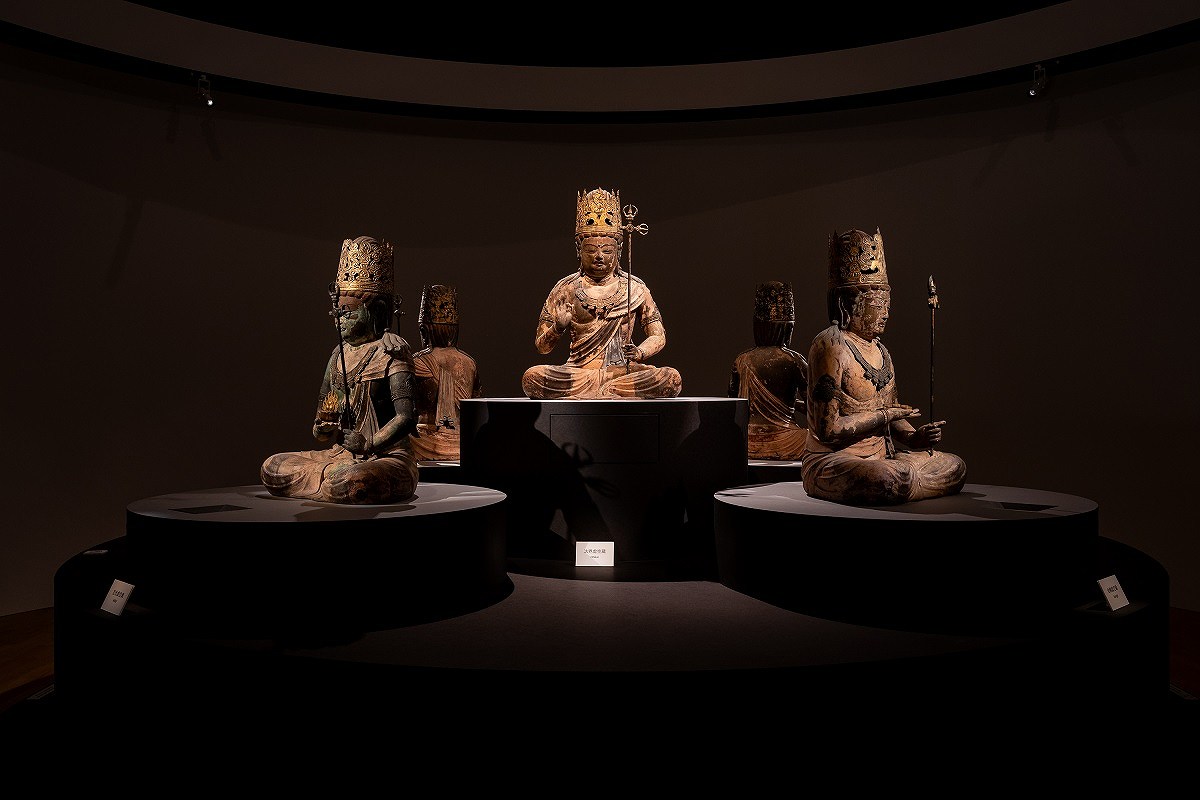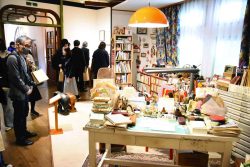Secret Treasures of 1,200-Year-Old Kyoto Temple at Tokyo Museum; Rarely Seen Items from Jingoji’s Collection Exhibited

The Five Great Manifestations of the Bodhisattva Kokuzo, property of Jingoji temple in Kyoto, sit in a meditative formation under dramatic lighting.
14:44 JST, August 17, 2024
In commemoration this year of the 1,200th anniversary of the founding of Kyoto’s Jingoji temple, the Tokyo National Museum in Taito Ward, Tokyo, is displaying rarely seen treasures including Buddhist statues and mandalas.
Over 100 items at the special exhibition, titled “Jingoji: The Dawn of Shingon Buddhism,” guide visitors through Japan’s rich history, which has been heavily influenced by Buddhism.
A standing statue of Yakushi Nyorai – the Buddha of Healing – particularly stands out. The exhibition in Tokyo is the first time it has ever been on public display outside of the temple.
“The clothing on the statue almost seems to ripple as it hangs down its form,” one of the organizers said.
The Shingon sect temple was established by Kukai (774-835) after he returned from China, where he learned esoteric Buddhist practices that are kept secret except for their transmission from teacher to disciple. Jingoji was used as Kukai’s base of operations around Kyoto.
In Shingon Buddhism, the creation of imagery is vital for teaching, ritual and as a show of devotion. This philosophy is clearly reflected in the temple’s vast collection.
The exhibition centerpiece is the Mandala of the Two Realms, also known as the “Takao Mandala,” a pair of massive red-purple silk scrolls with gold and silver paint. Together, their designs represent Shingon cosmology, with Dainichi Nyorai – the Cosmic Buddha – as their primary figure.
The scrolls were created in the 9th century under Kukai’s supervision. Over the centuries, they have undergone restoration work several times and were even reproduced in full in the 18th and 19th centuries.
Some items demonstrate the power and wealth of Jingoji’s patrons. When the temple fell into disrepair, it was revived by wealthy donors like Minamoto no Yoritomo, the founder of the Kamakura Shogunate. There is a full-size painting purported to be of Yoritomo along with a written deed of a donation he made.
One especially eye-catching donation is a collection of the Buddhist canon on indigo-colored scrolls with gold lettering, which was kept in silk covers and lacquered wooden boxes. The collection was given to the temple by a retired emperor.
“Over the past thousand years or more, people have rescued these items from fires and restored them many times over,” the organizer said. “We hope visitors can get a sense of that while viewing the exhibition.”
Organized by The Yomiuri Shimbun and other entities, the exhibition runs until Sept. 8. Admission is ¥2,100 for adults.
"Culture" POPULAR ARTICLE
-

Van Cleef & Arpels Dazzles with Art Deco Artisanry at Tokyo Exhibit
-

Disney’s ‘Twisted-Wonderland’ Animated Series Puts Villains in Spotlight: New Show Features School Inspired by Classic Disney Films
-

Ayumi Hamasaki’s Shanghai Concert Canceled Day Before Schedule as Part of Beijing Backlash
-

‘The World Masterpiece Theater Series’ Celebrates 50 Years; Animator Looks Back on Creating Anime Classics
-

Popularity of Piggy Banks Across Time and Place Seen at Bank’s Museum of Money Boxes in Hyogo Pref.
JN ACCESS RANKING
-

Tokyo Economic Security Forum to Hold Inaugural Meeting Amid Tense Global Environment
-

Keidanren Chairman Yoshinobu Tsutsui Visits Kashiwazaki-Kariwa Nuclear Power Plant; Inspects New Emergency Safety System
-

Imports of Rare Earths from China Facing Delays, May Be Caused by Deterioration of Japan-China Relations
-

University of Tokyo Professor Discusses Japanese Economic Security in Interview Ahead of Forum
-

Japan Pulls out of Vietnam Nuclear Project, Complicating Hanoi’s Power Plans























